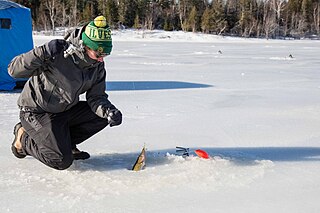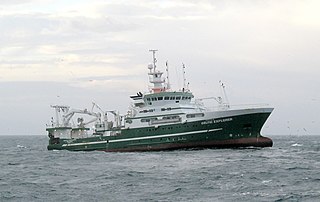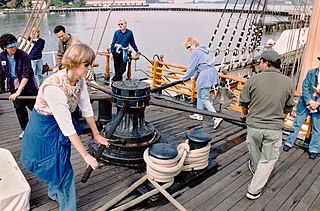
The Great Lakes, also called the Great Lakes of North America, are a series of large interconnected freshwater lakes spanning the Canada–United States border. The five lakes are Superior, Michigan, Huron, Erie, and Ontario. The Great Lakes Waterway enables modern travel and shipping by water among the lakes. The lakes connect to the Atlantic Ocean via the Saint Lawrence River.

Lake Erie is the fourth-largest lake by surface area of the five Great Lakes in North America and the eleventh-largest globally. It is the southernmost, shallowest, and smallest by volume of the Great Lakes and also has the shortest average water residence time. At its deepest point, Lake Erie is 210 feet (64 m) deep, making it the only Great Lake whose deepest point is above sea level.

The walleye, also called the walleyed pike, yellow pike, yellow pikeperch or yellow pickerel, is a freshwater perciform fish native to most of Canada and to the Northern United States. It is a North American close relative of the European zander, also known as the pikeperch. The walleye is sometimes called the yellow walleye to distinguish it from the blue walleye, which is a color morph that was once found in the southern Ontario and Quebec regions, but is now presumed extinct. However, recent genetic analysis of a preserved (frozen) 'blue walleye' sample suggests that the blue and yellow walleye were simply phenotypes within the same species and do not merit separate taxonomic classification.

Angling is a fishing technique that uses a fish hook attached to a fishing line to tether individual fish in the mouth. The fishing line is usually manipulated via a fishing rod, although rodless techniques such as handlining also exist. Modern angling rods are usually fitted with a fishing reel that functions as a cranking device for storing, retrieving and releasing out the line, although Tenkara fishing and traditional cane pole fishing are two rod-angling methods that do not use any reel. The fish hook itself can be additionally weighted with a denser tackle called a sinker, and is typically dressed with an appetizing bait to attract and entice the fish into swallowing the hook, but sometimes an inedible fake/imitation bait with multiple attached hooks is used instead of a single hook with edible bait. Some type of bite indicator, such as a float, a bell or a quiver tip, is often used to relay underwater status of the hook to the surface and alert the angler of a fish's presence.

Ice fishing is the practice of catching fish with lines and fish hooks or spears through an opening in the ice on a frozen body of water. Ice fishers may fish in the open or in heated enclosures, some with bunks and amenities.

A fishing trawler is a commercial fishing vessel designed to operate fishing trawls. Trawling is a method of fishing that involves actively dragging or pulling a trawl through the water behind one or more trawlers. Trawls are fishing nets that are pulled along the bottom of the sea or in midwater at a specified depth. A trawler may also operate two or more trawl nets simultaneously.

Gillnetting is a fishing method that uses gillnets: vertical panels of netting that hang from a line with regularly spaced floaters that hold the line on the surface of the water. The floats are sometimes called "corks" and the line with corks is generally referred to as a "cork line." The line along the bottom of the panels is generally weighted. Traditionally this line has been weighted with lead and may be referred to as "lead line." A gillnet is normally set in a straight line. Gillnets can be characterized by mesh size, as well as colour and type of filament from which they are made. Fish may be caught by gillnets in three ways:
- Wedged – held by the mesh around the body.
- Gilled – held by mesh slipping behind the opercula.
- Tangled – held by teeth, spines, maxillaries, or other protrusions without the body penetrating the mesh.

A fishing net is a net used for fishing. Some fishing nets are also called fish traps, for example fyke nets. Fishing nets are usually meshes formed by knotting a relatively thin thread. Early nets were woven from grasses, flaxes and other fibrous plant material. Later cotton was used. Modern nets are usually made of artificial polyamides like nylon, although nets of organic polyamides such as wool or silk thread were common until recently and are still used.

Bottom trawling is trawling along the seafloor. It is also referred to as "dragging". The scientific community divides bottom trawling into benthic trawling and demersal trawling. Benthic trawling is towing a net at the very bottom of the ocean and demersal trawling is towing a net just above the benthic zone. Bottom trawling can be contrasted with midwater trawling, where a net is towed higher in the water column. Midwater trawling catches pelagic fish such as anchovies and mackerel, whereas bottom trawling targets both bottom-living fish (groundfish) and semi-pelagic species such as cod, squid, shrimp, and rockfish.

A lobster trap or lobster pot is a portable trap that traps lobsters or crayfish and is used in lobster fishing. In Scotland, the word creel was used to refer to a device used to catch lobsters and other crustaceans. A lobster trap can hold several lobsters. Lobster traps can be constructed of wire and wood, metal and netting, or rigid plastic. An opening permits the lobster to enter a tunnel of netting or other one-way device. Pots are sometimes constructed in two parts, called the "chamber" or "kitchen", where there is bait, and exits into the "parlor", which prevents escape. Lobster pots are usually dropped to the sea floor, one or more at a time, sometimes up to 40 or more, and are marked by a buoy so they can be picked up later.

Seine fishing is a method of fishing that employs a surrounding net, called a seine, that hangs vertically in the water with its bottom edge held down by weights and its top edge buoyed by floats. Seine nets can be deployed from the shore as a beach seine, or from a boat.

A capstan is a vertical-axled rotating machine developed for use on sailing ships to multiply the pulling force of sailors when hauling ropes, cables, and hawsers. The principle is similar to that of the windlass, which has a horizontal axle.

Drift netting is a fishing technique where nets, called drift nets, hang vertically in the water column without being anchored to the bottom. The nets are kept vertical in the water by floats attached to a rope along the top of the net and weights attached to another rope along the bottom of the net. Drift nets generally rely on the entanglement properties of loosely affixed netting. Folds of loose netting, much like a window drapery, snag on a fish's tail and fins and wrap the fish up in loose netting as it struggles to escape. However, the nets can also function as gill nets if fish are captured when their gills get stuck in the net. The size of the mesh varies depending on the fish being targeted. These nets usually target schools of pelagic fish.

A fishing vessel is a boat or ship used to catch fish and other valuable nektonic aquatic animals in the sea, lake or river. Humans have used different kinds of surface vessels in commercial, artisanal and recreational fishing.

Basnig or balasnig are lift nets (salambaw) operated by a large outrigger boat called Basnigan. They use a large bag net suspended directly below or beside the ship. This net is attached to multiple temporary booms projecting from the ship's outriggers and detachable auxiliary masts. Modern basnig typically use generators and electric lights to attract fish and squid. This method is unique to the Philippines. It is common in the Visayas, particularly in the provinces of Capiz and Iloilo.

A factory ship, also known as a fish processing vessel, is a large ocean-going vessel with extensive on-board facilities for processing and freezing caught fish or whales. Modern factory ships are automated and enlarged versions of the earlier whalers, and their use for fishing has grown dramatically. Some factory ships are equipped to serve as a mother ship.

Fishing techniques are methods for catching fish. The term may also be applied to methods for catching other aquatic animals such as molluscs and edible marine invertebrates.

Shark Night is a 2011 American horror film directed by David R. Ellis and written by Will Hayes and Jesse Studenberg. It stars Sara Paxton, Chris Carmack, Katharine McPhee, Alyssa Diaz, Dustin Milligan, and Joel David Moore. The film, which was negatively received by critics and grossed $40 million worldwide, was released in RealD 3D and Digital 3D. This was Ellis's final film before his death.

Gimli is an unincorporated community in the Rural Municipality of Gimli on the west side of Lake Winnipeg in Manitoba, Canada.

Electric pulse fishing is a fishing technique sometimes used in trawl fisheries which produces a limited electric field above the seabed to catch fish. The pulse trawl gear consists of a number of electrodes, attached to the gear in the tow direction, that emit short electric pulses. The electrodes replace the tickler chains that are used in traditional beam trawl fishery. The pulse trawl fishery is mainly aimed at flatfish like sole, with by-catch plaice. In addition, the pulse trawl gear is applied in shrimp fisheries on a limited scale. Technically, the use of electricity to catch fish is prohibited in European waters. However, the European Union is able to provide exemptions to this rule since 2007. These exemptions are now mainly used by Dutch and British trawlers in the North Sea.





















